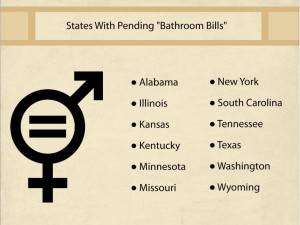By Megan Murphy
Copy Editor
By now, everyone has heard of the controversy surrounding North Carolina’s House Bill 2. In short, the act that was passed in March 2016 removes anti-discrimination policies for LGBT people as well as requiring people to use the bathroom that corresponds with their assigned gender at birth. Missouri has also recently started a bill to enact similar legislation.
This is a problem for transgender people because they often identify as the opposite gender to the one they were assigned at birth. They would prefer to use the bathroom that corresp onds with their gender identity and how they pass to the public.
onds with their gender identity and how they pass to the public.
For example, a transgender man, no matter how masculine he appears, would be required to use the women’s restroom unless he went through the lengthy process of changing his sex on his birth certificate, which in the state of Missouri requires expensive gender reassignment surgery. However, this requirement varies from state to state.
On February 22nd, President Trump removed the federal edict put into place by the Obama administration that would allow for students specifically to use the bathroom at school that best matched their preferred gender. When this is combined with the current push of legislation that decrees where trans people are allowed to go to the bathroom, problems arise for transgender people who would just like to use the restroom without a hassle.
In an interview last month on CBS’s “CBS This Morning”, transgender woman and activist Laverne Cox stated:
“These bills are not about bathrooms. They’re about whether trans people have the right to exist in public space. If we can’t access public bathrooms, we can’t go to school, we can’t work, we can’t go to health care facilities. This is about public accommodation.”
While many lawmakers who support these bills cite the fear that predators will pose as transgender women to assault women in bathrooms, there have been no cases thus far of any such event occurring.
Instead, there has been an increase in so-called “gender policing” in which people, transgender or not, who do not ascribe to gender norms have been attacked by people who are misguidedly attempting to protect women from assault in bathrooms.
Until President Trump undid the federal policy that Obama put into place for transgender students, they were able to use the bathroom that corresponded with their gender without issue, for the most part.
Some schools have implemented policies for trans students to use unisex one-stall bathrooms to avoid conflict. In fact, Crowder recently added gender-neutral bathrooms on campus.
“Crowder College wants to continue to provide accessible facilities for all students. Student Affairs staff identified the need for accessible restrooms. (By) working with facilities staff, (we) were able to work together and convert current restroom facilities into gender-neutral restrooms in the Student Center,” said Tiffany Slinkard, vice president of student affairs.
However, the fact remains that many public places don’t offer single stall bathrooms. Trans students as young as six years old have faced issues at school regarding which bathroom they should be using, per a report from CNN on February 27th.
From elementary school to post-secondary school, transgender students should be allowed to use the bathroom without fearing harassment. Transgender people deserve to live their lives as authentically as possible, and that includes having the same rights as cisgender people when it comes to using the restroom.
While single stall bathrooms offer a temporary solution to the controversy regarding bathroom rights, transgender people who pass as their identified gender have every right to use the bathroom regardless of what gender is listed is on their birth certificate.

Leave a Reply